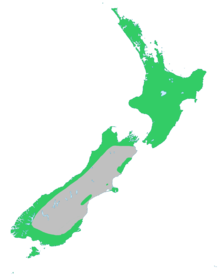- Dacrycarpus dacrydioides
-
Kahikatea 
Mature kahikatea tree Conservation status Scientific classification Kingdom: Plantae Division: Pinophyta Class: Pinopsida Order: Pinales Family: Podocarpaceae Genus: Dacrycarpus Species: D. dacrydioides Binomial name Dacrycarpus dacrydioides
(A.Rich.) de Laub.
Natural range of D. dacrydioides Synonyms Podocarpus dacrydioides, Dacrycarpus excelsum, Podocarpus thujoides, Dacrycarpus thuioides
Dacrycarpus ferrugineum
Nageia dacrydioides
Nageia excelsa
Podocarpus excelsus.Dacrycarpus dacrydioides or kahikatea (from its name in the Māori language) is a coniferous tree endemic to New Zealand.
The tree grows to a height of 55 metres (180 ft) with a trunk exceeding 1 metre (3 ft) in diameter, and is buttressed at the base. It is dominant in lowland forest and wetlands throughout the North and South Islands. The leaves are spirally arranged; on young plants, they are awl-shaped, 3 to 8 mm long, and twisted at the base to lie spread to the sides of the shoot in a flat plane; on mature trees, they are scale-like, 1 to 3 mm long, and placed all round the shoot. The cones are highly modified, with the cone scales swelling at maturity into an orange to red, fleshy, aril with a single apical seed 3 to 5 mm in diameter. The seeds are dispersed by birds, which eat the fleshy scale and pass the seeds in their droppings.
Before extensive logging, trees of 80 m height were known[citation needed]. A specimen on private land near Matirangi Forest in the Taranaki region is the tallest native tree in New Zealand at 56.4 metres (185 ft).[1] Tāne Mahuta, the famously large kauri tree (Agathis australis), is 51.2 m.
The tree was previously referred to by the misleading name "white pine", despite its not being a pine; the Māori name kahikatea is now more widely used (other Māori names are kaikatea, kahika, katea, kōaka).
Like many other species in the family Podocarpaceae, the classification of kahikatea has changed over time, having also been placed in the genera Podocarpus and Nageia.
Uses
The timber was initially not so highly regarded by European settlers as it was less attractive, strong, or resilient to rot than the other coniferous timbers available. However, since the wood does not impart an odour, and is clean and lightweight, Kahikatea was used to make boxes for the exporting of butter when the refrigerated export became feasible from Australia and New Zealand in the 1880s.[1] The butter was exported in 56 lb slabs, and kahikatea became less common as the export industry grew. Indeed, tall mature pure kaihikatea forest, a once distinctive and widespread wetland type, is all but gone except for very small patches mostly on the West Coast.
For Māori, the kahikatea had many uses. The fleshy aril or koroi was an important food resource, and was served at feasts in great amounts. The wood was also favoured for making bird spears. Soot obtained from burning the heartwood supplied a pigment for traditional tattooing (tā moko).
Kahikatea, along with other trees in privately owned forests, can only be harvested under a permit system and if sustainable harvesting techniques are used.
References
External links
- Gymnosperm Database - Dacrycarpus dacrydioides
- Environment Waikato - Kahikatea
- Conifer Specialist Group (1998). Dacrycarpus dacrydioides. 2006. IUCN Red List of Threatened Species. IUCN 2006. www.iucnredlist.org. Retrieved on 12 May 2006.
- http://www.nzes.org.nz/nzje/free_issues/ProNZES21_62.pdf The Kahikatea Forests of South Westland (New Zealand Journal of Ecology)
Categories:- IUCN Red List least concern species
- Podocarpaceae
- Trees of New Zealand
- Trees of mild maritime climate
- Least concern plants
Wikimedia Foundation. 2010.

